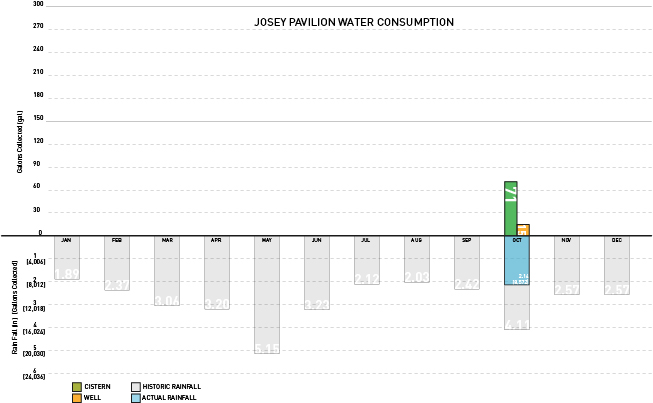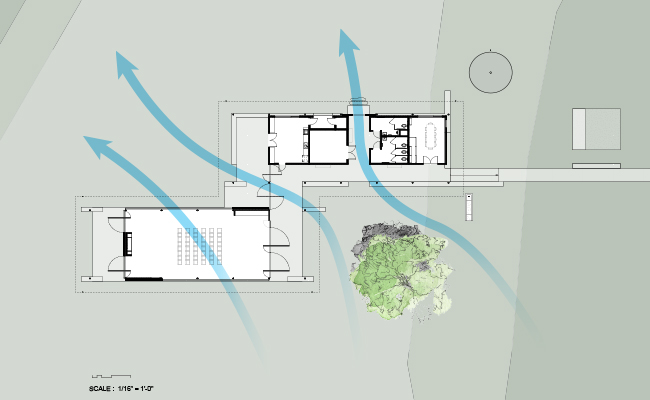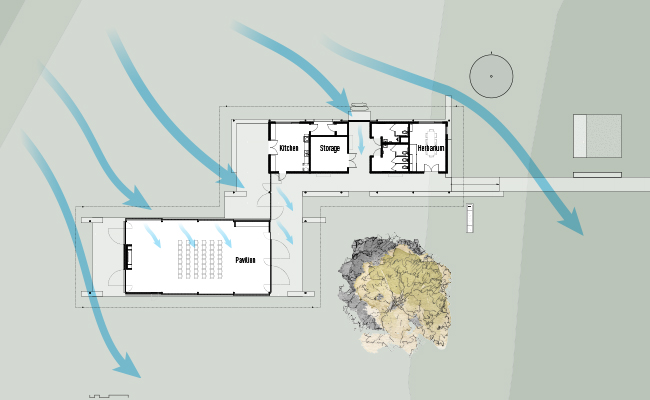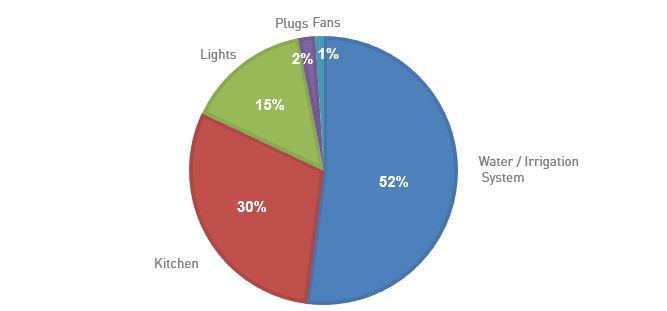THE DOGRUN
a place to share ideas


Josey Pavilion: One Month down, so far so good.
Posted by coreysquire on 11/3/14 at 9:01 pm
The Josey Pavilion, our first project seeking Living Building Challenge certification, began its operational phase on October 1st and things are looking good. During the month of October, Josey Consumed 139 kWh of electricity and generated 358 kWh. This is net positive usage of 219 kWh, meaning that 219 kWh of energy were sent back into the grid. Josey generated about 25% less energy than predicted, which is a little disconcerting but it also used less than half the energy that we had anticipated. A few more months like this and we should be in the clear.
This is the second post of a twelve post series on the process of obtaining Living Building Status. Each month over the next year, we will be posting an update on our water and energy usage as well as an overview on how we achieved each of the 20 imperatives mandated by The Living Building Challenge.
On the water side of the equation, Decatur, TX received 2.14 Inches of rainfall during October. This is about half the rain that we were expecting and another reminder of the severe drought conditions in Texas and that rainwater collection and filtration systems, like the one at Josey, will be become increasingly important in the future. Despite the lower than expected rainfall, Josey’s cistern collected over 8,000 gallons of water and only 71 gallons of that water was used for flushing toilets. An additional 15 gallons of water was pumped from the aquifer for potable use. These numbers are all on target for a low-use month and there is plenty of room for occupation to increase – as it undoubtedly will.
One fun aspect of a highly monitored building is that you never know what you might discover from the data. By digging into these numbers, we might be able to gain some insights into the occupant’s use habits. Josey’s low-flow toilets use 1.28 gallons per flush, so the toilets were flushed 55 times during October. If we guess that somewhere between 50 to 90 percent of potable water was used for hand washing (with 0.5 GPM faucets) that would mean that the average hand wash lasted between 15 and 30 seconds, right on target for the CDC’s recommendation of 20 seconds.
 Imperative of the Day: 07 Net Zero Energy
Imperative 07 Net Zero Energy along with Imperative 05 Net Zero Water and Imperative 11 Red List are traditionally the most difficult Living Building Challenge imperatives to achieve. But of the three, 07 Net Zero energy didn't end up being too bad. To our advantage, we had a relatively mild climate (by Texas standards), and a client who loved being outside and our comfort strategy was to rely on passive, rather than mechanical strategies. With the use of sliding and pivoting walls, the building was designed to transform depending on the season. During the summer, the pavilion can be entirely opened up to welcome cool breezes. During the winter, the space can bet closed off from harsh northern winds. By cutting out a mechanical system, we were able to cut the potential energy use by more than half.
Imperative of the Day: 07 Net Zero Energy
Imperative 07 Net Zero Energy along with Imperative 05 Net Zero Water and Imperative 11 Red List are traditionally the most difficult Living Building Challenge imperatives to achieve. But of the three, 07 Net Zero energy didn't end up being too bad. To our advantage, we had a relatively mild climate (by Texas standards), and a client who loved being outside and our comfort strategy was to rely on passive, rather than mechanical strategies. With the use of sliding and pivoting walls, the building was designed to transform depending on the season. During the summer, the pavilion can be entirely opened up to welcome cool breezes. During the winter, the space can bet closed off from harsh northern winds. By cutting out a mechanical system, we were able to cut the potential energy use by more than half.
 Open during the summer
Open during the summer
 Closed during the winter
After mechanical systems, the lighting load is usually the second highest energy consumer. Using sound rules of thumb and computer daylight simulations, we designed a building that is 100% daylit during daytime hours. All lights are on vacancy sensors which require somebody to manually turn them on, but then shut off automatically when they no longer sense movement.
Josey's projected energy use, about 2,000 kWh / year, is divided between the water treatment system, the catering kitchen, light, plugs, and fans. The pie chart below shows where Josey has been using energy thus far.
Closed during the winter
After mechanical systems, the lighting load is usually the second highest energy consumer. Using sound rules of thumb and computer daylight simulations, we designed a building that is 100% daylit during daytime hours. All lights are on vacancy sensors which require somebody to manually turn them on, but then shut off automatically when they no longer sense movement.
Josey's projected energy use, about 2,000 kWh / year, is divided between the water treatment system, the catering kitchen, light, plugs, and fans. The pie chart below shows where Josey has been using energy thus far.

 Imperative of the Day: 07 Net Zero Energy
Imperative 07 Net Zero Energy along with Imperative 05 Net Zero Water and Imperative 11 Red List are traditionally the most difficult Living Building Challenge imperatives to achieve. But of the three, 07 Net Zero energy didn't end up being too bad. To our advantage, we had a relatively mild climate (by Texas standards), and a client who loved being outside and our comfort strategy was to rely on passive, rather than mechanical strategies. With the use of sliding and pivoting walls, the building was designed to transform depending on the season. During the summer, the pavilion can be entirely opened up to welcome cool breezes. During the winter, the space can bet closed off from harsh northern winds. By cutting out a mechanical system, we were able to cut the potential energy use by more than half.
Imperative of the Day: 07 Net Zero Energy
Imperative 07 Net Zero Energy along with Imperative 05 Net Zero Water and Imperative 11 Red List are traditionally the most difficult Living Building Challenge imperatives to achieve. But of the three, 07 Net Zero energy didn't end up being too bad. To our advantage, we had a relatively mild climate (by Texas standards), and a client who loved being outside and our comfort strategy was to rely on passive, rather than mechanical strategies. With the use of sliding and pivoting walls, the building was designed to transform depending on the season. During the summer, the pavilion can be entirely opened up to welcome cool breezes. During the winter, the space can bet closed off from harsh northern winds. By cutting out a mechanical system, we were able to cut the potential energy use by more than half.
 Open during the summer
Open during the summer
 Closed during the winter
After mechanical systems, the lighting load is usually the second highest energy consumer. Using sound rules of thumb and computer daylight simulations, we designed a building that is 100% daylit during daytime hours. All lights are on vacancy sensors which require somebody to manually turn them on, but then shut off automatically when they no longer sense movement.
Josey's projected energy use, about 2,000 kWh / year, is divided between the water treatment system, the catering kitchen, light, plugs, and fans. The pie chart below shows where Josey has been using energy thus far.
Closed during the winter
After mechanical systems, the lighting load is usually the second highest energy consumer. Using sound rules of thumb and computer daylight simulations, we designed a building that is 100% daylit during daytime hours. All lights are on vacancy sensors which require somebody to manually turn them on, but then shut off automatically when they no longer sense movement.
Josey's projected energy use, about 2,000 kWh / year, is divided between the water treatment system, the catering kitchen, light, plugs, and fans. The pie chart below shows where Josey has been using energy thus far.

